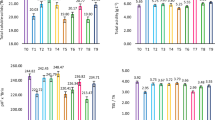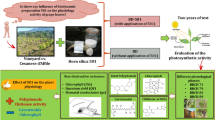Abstract
Wounding is a common stress factor for plants, caused by abiotic elements. Plants have the ability to respond to the combined influence of different factors such as temperature fluctuations, radiation, precipitation, CO2 levels, and human-induced impacts. Vitis vinifera L., a resilient species capable of withstanding adverse conditions, offers the opportunity to manipulate quality attributes through viticultural practices. In the 2021 growing season, an experiment was conducted in a commercial vineyard situated in Tekirdağ, Turkey, to investigate the effects of leaf artificial stress treatments on clusters and berries of 21-year-old ‘Merlot’ grapevines (Vitis vinifera L.) grafted on SO4 rootstocks. Employing a completely randomized block design, leaf artificial stress treatments (T0, T1, T2, T3, T4, T5, T6, T7, T8, and T9) were applied from different row directions and at various times. Overall, the artificial stress treatments did not significantly affect measured criteria such as berry weight, diameter, length, dry weight, volume, density, number of seeds, percentage of dry weight, skin area, and the ratio of berry skin area and berry volume (BSA/BVOL). However, notable discrepancies were observed among certain criteria across the treatments. T4 exhibited the highest mean berry weight and diameter, whereas T6 had the lowest. T3 displayed the highest mean berry length, while T6 had the lowest. T8 showed the highest mean berry dry weight, whereas T6 had the lowest. T4 yielded the highest mean berry volume, while T6 had the lowest. T7 had the highest mean berry density, with T4 having the lowest. T4 also had the highest mean number of berry seeds, while T6 had the lowest. The BSA/BVOL ratio remained relatively consistent across treatments, ranging from 4.26 to 4.58, implying that it may be less susceptible to artificial stress treatments compared to other criteria. Further investigations are required to examine the long-term effects of leaf artificial stress treatments and establish direct correlations between these treatments and their responses.








Similar content being viewed by others
References
Abay C (2022) The effects of some abiotic stresses on primary and secondary metabolits in cv. Cabernet-Sauvignon (Vitis vinifera L.) (in Turkish with English abstract). Tekirdağ Namık Kemal University, Tekirdağ (Master’s thesis)
Bahar E, Korkutal İ, Kurt C (2011) Water deficit effect on different phenological growth stages in grape berry growing, development and quality (in Turkish with English abstract). Trak Univ J Nat Sci 12:23–34
Bahar E, Carbonneau A, Korkutal I (2017) Vine and berry responses to severe water stress in different stages in cv. Syrah (Vitis vinifera L.). Jotaf 14:62–70
Barbagallo MG, Guidoni S, Hunter JJ (2011) Berry size and qualitative characteristics of Vitis vinifera L. cv. Syrah. Sajev 32(1):129–136. https://doi.org/10.21548/32-1-1372
Candar S (2022) Effects of mechanically induced abiotic stress on berry and cluster physical properties of cv. Cabernet sauvignon grape variety. Cukurova 8th International Scientific Researches Conference, Adana, 15–17 April. Full Texts Book, vol 1, pp 1028–1037. ISBN 9786258377514.
Candar S (2023) How abiotic stress induced by artificial wounding changes maturity levels and berry composition of Merlot (Vitis vinifera L.). Eur Food Res Technol. https://doi.org/10.1007/s00217-023-04318-6
Candar S, Bahar E, Korkutal İ, Alço T, Gülcü M (2019a) The effects of different green pruning applications on berry maturaton in Merlot (Vitis vinifera L.) (in Turkish with English abstract). Adnan Menderes Uni J Agric Sci 16(1):53–61. https://doi.org/10.25308/aduziraat.520923
Candar S, Alço T, Yaşasın A, Korkutal İ, Bahar E (2019b) Evaluation of long term changes for viticultural indices in Turkey Thrace (in Turkish with English abstract). Comujaf 7(2):259–268. https://doi.org/10.33202/comuagri.524811
Candar S, Bahar E, Korkutal İ (2020) Impacts of leaf area on the physiological activity and berry maturation of Merlot (Vitis vinifera L.). Appl Ecol Environ Res 18(1):1523–1538. https://doi.org/10.15666/aeer/1801_15231538
Castellarin SD, Matthews MA, Di Gaspero G, Gambetta GA (2007) Water deficits accelerate ripening and induce changes in gene expression regulating flavonoid biosynthesis in grape berries. Planta 227:101–112. https://doi.org/10.1007/s00425-007-0598-8
Chen WK, He F, Wang YX, Liu X, Duan CQ, Wang J (2018) Influences of berry size on fruit composition and wine quality of Vitis vinifera L. cv. ‘Cabernet Sauvignon’ grapes. Sajev 39(1):67–76. https://doi.org/10.21548/39-1-2439
Coombe BG, McCarthy MG (2000) Dynamics of grape berry growth and physiology of ripening. Aust J Grape Wine Res 6(2):131–135. https://doi.org/10.1111/j.1755-0238.2000.tb00171.x
Deloire A, Ojeda H, Zebic O, Bernard N, Hunter JJ, Carbonneau A (2005) Influence de l’état hydrique de la vigne sur le style de vin. Progr Agric Vitic 21:455–461
Ferrara G, Gallotta A, Pacucci C, Matarrese AMS, Mazzeo A, Giancaspro A, Gadaleta A, Piazzolla F, Colelli G (2017) The table grape ‘Victoria’ with a long shaped berry: a potential mutation with attractive characteristics for consumers. J Sci Food Agric 97(15):5398–5405. https://doi.org/10.1002/jsfa.8429
Hunter JJ, Ruffner HP, Volschenk CG, Le Roux DJ (1995) Partial defoliation of Vitis vinifera L. cv Cabernet Sauvignon/99 Richter: Effect on root growth, canopy efficiency, grape composition and wine quality. Ajev 46:306–314
Jones HG, Jones MB (1989) Introduction: some terminology and common mechanisms. In: Jones HG, Flowers TJ, Jones MB (eds) Plants under stress. Cambridge University Press, Cambridge, pp 1–10
King PD, Smart RE, McClellan DJ (2015) Timing of crop removal has limited effect on Merlot grape and wine composition. Agric Sci 6(4):456–465. https://doi.org/10.4236/as.2015.64045
Kok D, Bal E, Celik S (2013) Influences of various canopy management techniques on wine grape quality of V. vinifera L. cv. Kalecik Karası. Bjas 19(6):1247–1252
Korkutal İ, Bahar E (2013) Influence of different soil tillage and leaf removal treatments on yield, cluster and berry characteristics in cv. Syrah (Vitis vinifera L.). Bjas 19(4):652–663
Korkutal İ, Bahar E, Bayram S (2017) Different soil tillage and leaf removals effects on water stress, berry and cluster properties of cv. Syrah (in Turkish wtih English abstract). J Agric Fac Ege Uni 54(4):397–407. https://doi.org/10.20289/zfdergi.386422
Korkutal İ, Bahar E, Carbonneau A (2019) Early water stress effects on pollen viability, berry set and embryo development in cv. ‘Syrah’ (Vitis vinifera L.). J Hortic Sci 46(4):215–223. https://doi.org/10.17221/110/2018-HORTSCI
Korkutal İ, Bahar E, Güvemli DD (2020) Determination the effects of antitranspirant application on the grape berry and cluster characteristics in veraison and post-veraison period (in Turkish wtih English abstract). J Agric Fac Ege Uni 57(1):83–93. https://doi.org/10.20289/zfdergi.594224
Korkutal İ, Bahar E, Azsöz S (2021) Determination of the effects of leaf removal and cluster thinning applications at different times in cv. Michele Palieri on cluster properties (in Turkish with English abstract). Mustafa Kemal Uni J Agric Sci 26(2):376–386. https://doi.org/10.37908/mkutbd.908853
Lorenz D, Eichhorn K, Bleiholder H, Klose R, Meier U (1995) Phenological growth stages of the grapevine (Vitis vinifera L. ssp. vinifera)-codes and descriptions according to the extended BBCH scale. Aust J Grape Wine Res. https://doi.org/10.1111/j.17550238.1995.tb00085.x
Mateus N, Marques S, Goncalves AC, Machado JM, De Freitas V (2001) Proanthocyanidin composition of red Vitis vinifera varieties from the Douro Valley during ripening: Influence of cultivation altitude. Ajev 52:115–121
Matthews MA, Nuzzo V (2007) Berry size and yield paradigms on grapes and wines quality. Acta Hortic 745:423–436. https://doi.org/10.17660/actahortic.2007.754.56
OIV (2021) Compendium of international methods of wine and musts. Vol 2. https://www.oiv.int/int. Accessed 4 June 2021
Palma L, Novello V, Tarricome L, Frabboni L, Lopriore G, Soleti F (2007) Grape and wine quality as influenced by the agronomical soil protection in a viticultural system of southern Italy. Quaderni Sci Viticole Enol Univ Torino 29:83–111
Pelsy F (2010) Molecular and cellular mechanisms of diversity within grapevine varieties. Heredity 104(4):331–340
Poni S, Bernizzoni F, Civardi S, Libelli N (2009) Effects of pre-bloom leaf removal on growth of berry tissues and must composition in two red Vitis vinifera L. cultivars. J Grape Wine Res 15(2):185–193. https://doi.org/10.1111/j.1755-0238.2008.00044.x
Poni S, Gatti M, Palliotti A, Dai Z, Duchêne E, Truong TT, Ferrara G, Matarrese AMS, Gallotta A, Bellincontro A, Mencarelli F, Tombesi S (2018) Grapevine quality: a multiple choice issue. Sci Hortic 234(14):445–462. https://doi.org/10.1016/j.scienta.2017.12.035
R Core Team (2016) R: a language and environment for statistical computing. R Foundation for Statistical Computing, Vienna
Roby G, Matthews M (2004) Relative proportions of seed, skin and flesh, in ripe berries from Cabernet Sauvignon grapevines grown in a vineyard either well irrigated or under water deficit. Aust J Grape Wine Res 10(1):74–82. https://doi.org/10.1111/j.1755-0238.2004.tb00009.x
van Schalkwyk D (2004) Methods to determine berry mass, berry volume and bunch mass. Wynboer, A Technical Guide for Wine Producers. http://www.wynboer.co.za/recentarticles/0409methods.php3. Accessed 4 Mar 2022
Tok Abay C (2021) The effects of some abiotic and biotic stresses on primary and secondary metabolits in cv. Cabernet-sauvignon and cv. Merlot (in Turkish with English abstract). Tekirdağ Namık Kemal University, Tekirdağ (Master’s thesis)
Acknowledgements
The author would like to thank Elman Bahar for helping in the design of the trial, Ecem Kübra Demirkapı and Özgür Aygan for their contributions to the field and laboratory work, Jannat Khan for English grammar check and visualizations, and İlknur Korkutal for her contribution to the intellectual content of the article.
Funding
This study was not funded from any source.
Author information
Authors and Affiliations
Contributions
The author is responsible for all stages of the study, including the design and carrying out of the experiment, the data collection, and the article’s writing.
Corresponding author
Ethics declarations
Conflict of interest
S. Candar declares that he has no competing interests.
Additional information
Publisher’s Note
Springer Nature remains neutral with regard to jurisdictional claims in published maps and institutional affiliations.
Rights and permissions
Springer Nature or its licensor (e.g. a society or other partner) holds exclusive rights to this article under a publishing agreement with the author(s) or other rightsholder(s); author self-archiving of the accepted manuscript version of this article is solely governed by the terms of such publishing agreement and applicable law.
About this article
Cite this article
Candar, S. Understanding the Impact of Artificial Stress on the Morphological Characteristics of cv. ‘Merlot’ Berry and Cluster. Applied Fruit Science 66, 257–267 (2024). https://doi.org/10.1007/s10341-023-01002-7
Received:
Accepted:
Published:
Issue Date:
DOI: https://doi.org/10.1007/s10341-023-01002-7




